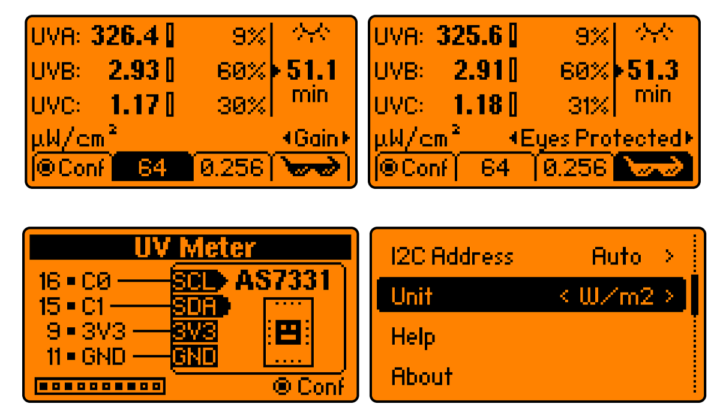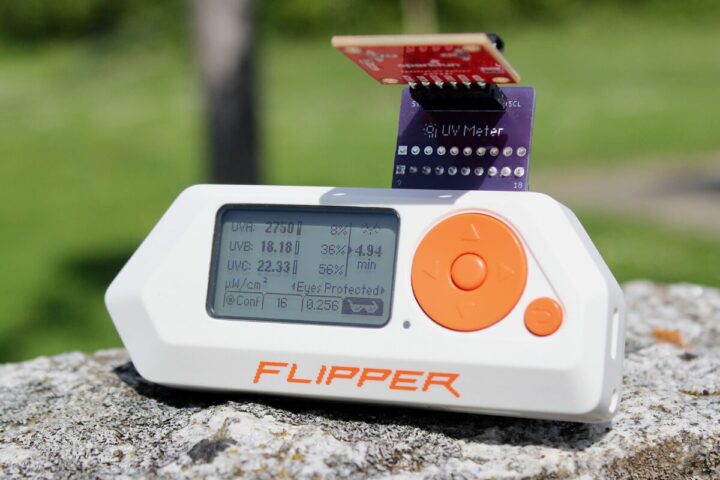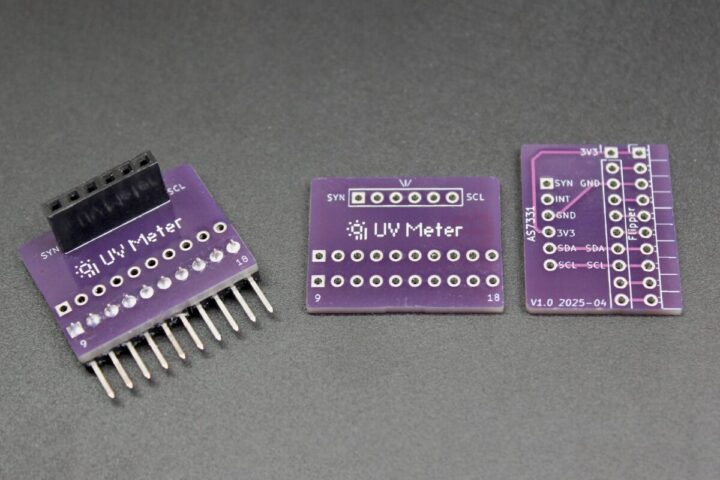The UV Meter is a Flipper Zero application designed to measure ultraviolet (UV) radiation using the AS7331 spectral sensor, which can detect UV-A, UV-B, and UV-C wavelengths. Designed for personal and environmental UV monitoring, this tool measures UV exposure levels in everyday scenarios, whether it’s behind windows, under cloud cover, or while wearing sunglasses.
It provides real-time irradiance readings in µW/cm², W/m², or mW/m², and calculates safe maximum daily exposure durations based on 2024 TLVs and BEIs from ACGIH, with adjustable factors like eye protection status, gain, and exposure time. A visual meter and warning symbols notify the user of under- or overexposure. The app also displays each UV type’s relative contribution to overall exposure risk. A compact adapter PCB enables easy connection between the Flipper Zero and the AS7331 breakout board via I²C.
Flipper Zero UV Meter specifications:
- Target platform – Flipper Zero
- Sensor module – Sparkfun AS7331 Spectral Sensor for independent measurements of UV-A, UV-B, and UV-C
- Interface – I2C
- SCL → C0 (Pin 16)
- SDA → C1 (Pin 15)
- Data output
- Real-time UV intensity readings
- Units: µW/cm², mW/m², W/m²
- Raw sensor value bar meters with over/underexposure indicators
- Exposure measurement
- Calculates maximum daily exposure duration based on:
- 2024 TLVs and BEIs by ACGIH
- 8-hour work shift reference
- Eye protection status (toggleable in settings)
- Displays the contribution percentage from each UV band
- Warnings for unsafe exposure thresholds
- Calculates maximum daily exposure duration based on:
- User settings
- Manual I²C address selection
- Gain and exposure time adjustments (similar to ISO/shutter speed)
- Eye protection toggle for adjusted safety calculations
- Adapter PCB – Custom KiCad-designed PCB
- Adapter PCB Dimensions – 25.8 mm x 20.3 mm
In terms of software, Baisch mentions that the software for the UV Meter application was developed from scratch, which went well beyond basic tutorials and existing libraries from SparkFun. Ultimately, he created his own AS7331 library to manage the sensor’s measurement settings (like Gain, Integration Time, and Divider), and raw data conversion into meaningful µW/cm² readings.

He also created an interface for the Flipper Zero’s 128×64 pixel screen, displaying UV-A, UV-B, and UV-C readings, alongside a calculated maximum daily exposure duration based on ACGIH guidelines. This involved moving from a simple ViewPort to a SceneManager/ViewDispatcher architecture to handle different screens, including a settings menu, “About,” and “Help” sections, and a visual guide for sensor wiring.
The UV meter adds to many existing extensions for the Flipper Zero, such as the Flipper Blackhat dual-band Wi-Fi card running Linux and designed for penetration testing, Sacred Labs’ FlipMods Combo extension module that combines an ESP32, CC1101 Sub-GHz wireless MCU, and a GPS module, and a CAN Bus add-on board among others.
He also designed a custom PCB for the flipper to connect the sensor early module to the flipper without the need for wires. After finishing the device and UI, he tested it, and the result was surprising, to say the least. It turns out you’re likely less protected from UV than you think. Consider better sun protection this summer, or you can just build your own Flipper Zero UV meter. More information about the project can be found on Michael Baisch’s website or his GitHub repository. Everything is open-sourced, so you can build the project yourself very easily.
Via Hackster.io
Debashis Das is a technical content writer and embedded engineer with over five years of experience in the industry. With expertise in Embedded C, PCB Design, and SEO optimization, he effectively blends difficult technical topics with clear communication
Support CNX Software! Donate via cryptocurrencies, become a Patron on Patreon, or purchase goods on Amazon or Aliexpress. We also use affiliate links in articles to earn commissions if you make a purchase after clicking on those links.





some light bulbs emit uvc itd be useful for detecting small holes in coating to prevent just that